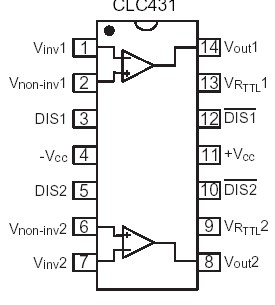CLC431: Features: ·Wide bandwidth: 92MHz (AV=+1) 62MHz (Av=+2)·Fast slew rate: 2000V/ms·Fast disable: 1ms to high-Z output·High channel isolation: 70dB at 10MHz·Single or dual supplies: ±5V to ±16.5VApplica...
floor Price/Ceiling Price
- Part Number:
- CLC431
- Supply Ability:
- 5000
Price Break
- Qty
- 1~5000
- Unit Price
- Negotiable
- Processing time
- 15 Days
SeekIC Buyer Protection PLUS - newly updated for 2013!
- Escrow Protection.
- Guaranteed refunds.
- Secure payments.
- Learn more >>
Month Sales
268 Transactions
Payment Methods
All payment methods are secure and covered by SeekIC Buyer Protection PLUS.

 CLC431 Data Sheet
CLC431 Data Sheet








